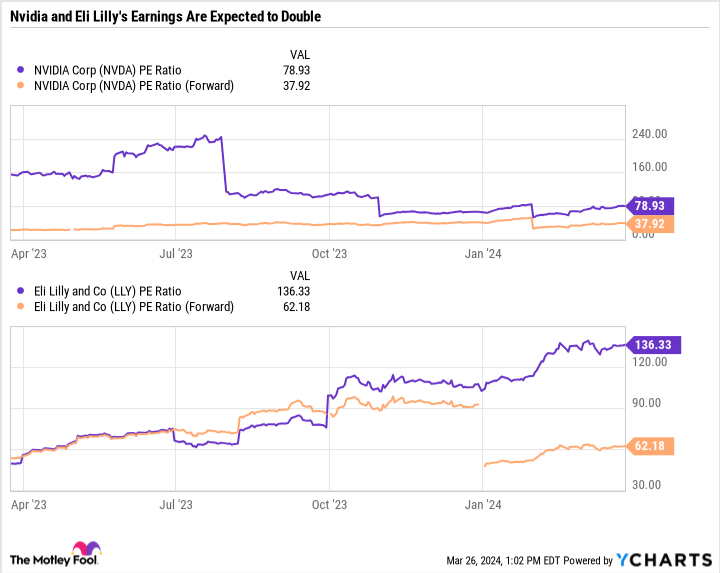We’re only one quarter into 2024 and already the Nasdaq Composite and S&P 500 are up over 9% year to date. But Vanguard’s largest growth-focused exchange-traded fund (ETF) is up even more.
Here’s why the Vanguard Growth ETF (VUG -0.24%) continues to outperform the major indexes while achieving diversification, why the ETF could continue to outperform, and whether it is worth buying now.
Image source: Getty Images.
Built to let winners run
The Vanguard Growth ETF targets the largest U.S.-based growth stocks no matter the industry or exchange they trade on. This is a different approach than the S&P 500 — which tracks the 500 largest U.S.-based companies by market cap (although there are a few other qualifications) or the Nasdaq Composite, which covers the largest companies on the Nasdaq Stock Market, but not the New York Stock Exchange.
Although the Nasdaq typically includes younger, more growth-focused companies, the New York Stock Exchange has some high-powered growth stocks that you wouldn’t get if you bought a Nasdaq ETF, like drug maker Eli Lilly. Or Visa and Mastercard, which have consistently outperformed the broader financial sector.
The inherent structure of the Vanguard Growth ETF means that it should outperform the Nasdaq Composite and S&P 500 if large-cap growth is leading the market, which is precisely what has been happening in 2023, 2024, and for most of the last five years.
|
Security |
YTD Total Return |
1-Year Total Return |
3-Year Total Return |
5-Year Total Return |
|---|---|---|---|---|
|
Vanguard Growth ETF |
11.2% |
44.1% |
39.9% |
131.7% |
|
Nasdaq Composite |
9.3% |
39.7% |
39.9% |
123.8% |
|
S&P 500 |
9.8% |
33.5% |
29.3% |
102.8% |
Data source: YCharts. YTD = year to date.
A “Magnificent” concentration
Over 50% of the Vanguard Growth ETF is weighted in the “Magnificent Seven” stocks — a term coined by Bank of America analyst Michael Hartnett to describe seven large, tech-focused companies. The ETF has a far higher concentration in the Magnificent Seven than the SPDR S&P 500 ETF or even the Invesco QQQ, which mirrors the performance of the Nasdaq-100. The Nasdaq-100 covers the 100 largest non-financial companies listed on the exchange.
|
Security |
Microsoft |
Apple |
Nvidia |
Amazon |
Alphabet |
Meta Platforms |
Tesla |
|---|---|---|---|---|---|---|---|
|
Vanguard Growth ETF |
12.8% |
11.2% |
7.8% |
6.9% |
6.3% |
4.5% |
2.3% |
|
Invesco QQQ |
8.8% |
7.4% |
6.6% |
5.2% |
4.9% |
4.9% |
2.3% |
|
SPDR S&P 500 ETF |
7.2% |
5.7% |
5.4% |
3.8% |
3.7% |
2.5% |
1.1% |
Data sources: Vanguard, Invesco, State Street Global Advisers.
The higher weightings in outperforming stocks like Microsoft, Nvidia, and Amazon offset the underperformance of higher-weighed stocks like Apple, Alphabet, and Tesla. As mentioned earlier, the Vanguard Growth ETF has more flexibility regarding what stocks it can include, allowing it to take advantage of growth across different pockets of the market.
You get what you wish for
The biggest drawback of the Vanguard Growth ETF is its valuation. The price-to-earnings (P/E) ratio is a sky-high 41.6 compared to 36.3 for the Invesco QQQ and 26.2 for the SPDR S&P 500 ETF. An expensive valuation is what you get with heavy concentration in premium-priced stocks — like most of the Magnificent Seven. However, P/E based on trailing-12-month earnings only tells part of the story.
Nvidia and Eli Lilly, which collectively make up a whopping 10.4% of the Vanguard Growth ETF, have very high P/E ratios. But analyst consensus estimates forecast their earnings to more than double over the next 12 months — which is why their forward P/E ratios are less than half current P/E ratios.
NVDA PE Ratio data by YCharts
The valuations of Nvidia and Ely Lilly are a good lesson in why a growth-focused ETF can look so expensive in the short term but is actually more reasonable if earnings deliver. Granted, there’s a lot of uncertainty when it comes to banking on forward earnings. These are just projections, and a lot can go wrong within and outside of a company’s control.
A good option if it fits your investment objectives
The Vanguard Growth ETF gives growth investors the complete package of diversification and high weightings in the market’s top growth stocks. At a mere 0.04% expense ratio, a $1,000 investment in the fund would incur just $0.40 in annual fees.
The ETF just made a new all-time high and is more expensive than it used to be. But investors shouldn’t be approaching growth ETFs or growth stocks in general based on their past earnings, but on what the investment could deliver in the future.
The ETF will probably continue to be more volatile than the S&P 500. But it’s worth considering if you want to invest in growth but don’t know where to start or are just looking for a simple way to add to your growth holdings without incurring high fees from more expensive financial products.
Bank of America is an advertising partner of The Ascent, a Motley Fool company. John Mackey, former CEO of Whole Foods Market, an Amazon subsidiary, is a member of The Motley Fool’s board of directors. Randi Zuckerberg, a former director of market development and spokeswoman for Facebook and sister to Meta Platforms CEO Mark Zuckerberg, is a member of The Motley Fool’s board of directors. Suzanne Frey, an executive at Alphabet, is a member of The Motley Fool’s board of directors. Daniel Foelber has no position in any of the stocks mentioned. The Motley Fool has positions in and recommends Alphabet, Amazon, Apple, Bank of America, Mastercard, Meta Platforms, Microsoft, Nvidia, Tesla, Vanguard Index Funds-Vanguard Growth ETF, and Visa. The Motley Fool recommends the following options: long January 2025 $370 calls on Mastercard, long January 2026 $395 calls on Microsoft, short January 2025 $380 calls on Mastercard, and short January 2026 $405 calls on Microsoft. The Motley Fool has a disclosure policy.















